
A research team led by the Department of Ophthalmology, School of Clinical Medicine, LKS Faculty of Medicine of The University of Hong Kong (HKUMed), with collaborators from the Faculty of Medicine of The Chinese University of Hong Kong (CU Medicine) and local and international partners, have developed a new technology ROTA (Retinal nerve fiber layer Optical Texture Analysis) to unveil the optical texture and trajectories of the axonal fiber bundles on the retina. ROTA outperforms the current clinical standards, attaining 15.0% to 28.4% higher in sensitivity in detecting early optic nerve damage in glaucoma—the leading cause of irreversible blindness. The research has been published in Nature Biomedical Engineering.
Glaucoma is the most common form of neurodegenerative disease. Whereas clinical diagnosis of glaucoma is predicated on the measurement of retinal nerve fiber layer (RNFL) thickness, typically obtained with a non-invasive digital imaging device, optical coherence tomography (OCT), false positives and false negatives are common, which renders clinical interpretation of OCT findings difficult, even for glaucoma specialists. This is supported by a meta-analysis reporting that the sensitivities of best-performing OCT parameters for detection of RNFL thickness abnormalities were only 65%–75% at specificities of 90%–95%.
ROTA is a patented algorithm that integrates RNFL thickness and RNFL reflectance measurements obtained from standard OCT scans to discern the optical texture and trajectories of the axonal fiber bundles and reveal RNFL defects. ROTA can detect focal RNFL defects that are missed by standard clinical tests.
Compared with OCT, ROTA can increase the sensitivity of detecting early optic nerve damage in glaucoma by 15–22%. At 95% specificity, the sensitivity of ROTA was 97.3–98.4% for detection of early glaucoma, 15.0% to 28.4% higher than the current clinical standards. HKUMed is working with the University of California San Diego (UCSD), the United States, to apply ROTA in research and patient care, while patients can find the application of ROTA at HKU Eye Center and Southern District Hong Kong Eye Survey.
In a diagnostic study examining 177 healthy individuals and 363 glaucoma patients at the CUHK Eye Center of CU Medicine, ROTA attained significantly higher sensitivity and specificity than conventional OCT RNFL thickness analysis to detect glaucoma. Furthermore, ROTA is able to identify axonal fiber bundle damage in optic neuritis, ischemic optic neuropathy, and compressive optic neuropathy.
“We are delighted to have worked with CU Medicine to develop ROTA, which brings new hope to early identification and timely treatment of glaucoma due to its high sensitivity and specificity,” said Professor Christopher Leung Kai-shun, Chairperson and Clinical Professor of the Department of Ophthalmology, School of Clinical Medicine, HKUMed. “Our next steps include enrolling patients from Queen Mary Hospital, Grantham Hospital, and Hong Kong Eye Hospital for longitudinal studies to examine the effectiveness of ROTA for detection of glaucoma progression, as well as working with OCT industrial partners to deploy ROTA in clinical care. Furthermore, HKU Eye Center welcomes patients with questionable diagnosis of glaucoma for ROTA assessment.”
Professor Clement Tham Chee-yung, Chairman of the Department of Ophthalmology and Visual Sciences and S.H. Ho Professor of Ophthalmology and Visual Sciences, CU Medicine, said, “Glaucoma can lead to irreversible loss of vision, if it is not diagnosed and treated early. In Hong Kong, about 25% of irreversible blindness is caused by glaucoma, and there are more about 100,000 glaucoma patients suffering from various levels of visual disability. Achieving earlier diagnosis of glaucoma and detection of progression through advanced imaging technologies is essential. I am glad that ROTA was developed by CU Medicine and HKUMed’s collaboration and now it can be used in clinical practice.”
ROTA underpins a highly sensitive and specific technique to advance the diagnosis of glaucoma and optic neuropathies. ROTA will be deployed on the Advanced Nerve and Glaucoma Imaging Network (ANGI Network), which comprises ophthalmologists, neuro-ophthalmologists and clinical researchers around the world.
Christopher Kai Shun Leung et al, Diagnostic assessment of glaucoma and non-glaucomatous optic neuropathies via optical texture analysis of the retinal nerve fibre layer, Nature Biomedical Engineering (2022). DOI: 10.1038/s41551-021-00813-x
Citation:
New technology to visualize axonal fiber bundles on the retina for early diagnosis of optic neuropathies (2022, September 9)
retrieved 12 September 2022
from https://medicalxpress.com/news/2022-09-technology-visualize-axonal-fiber-bundles.html
This document is subject to copyright. Apart from any fair dealing for the purpose of private study or research, no
part may be reproduced without the written permission. The content is provided for information purposes only.
Source link




